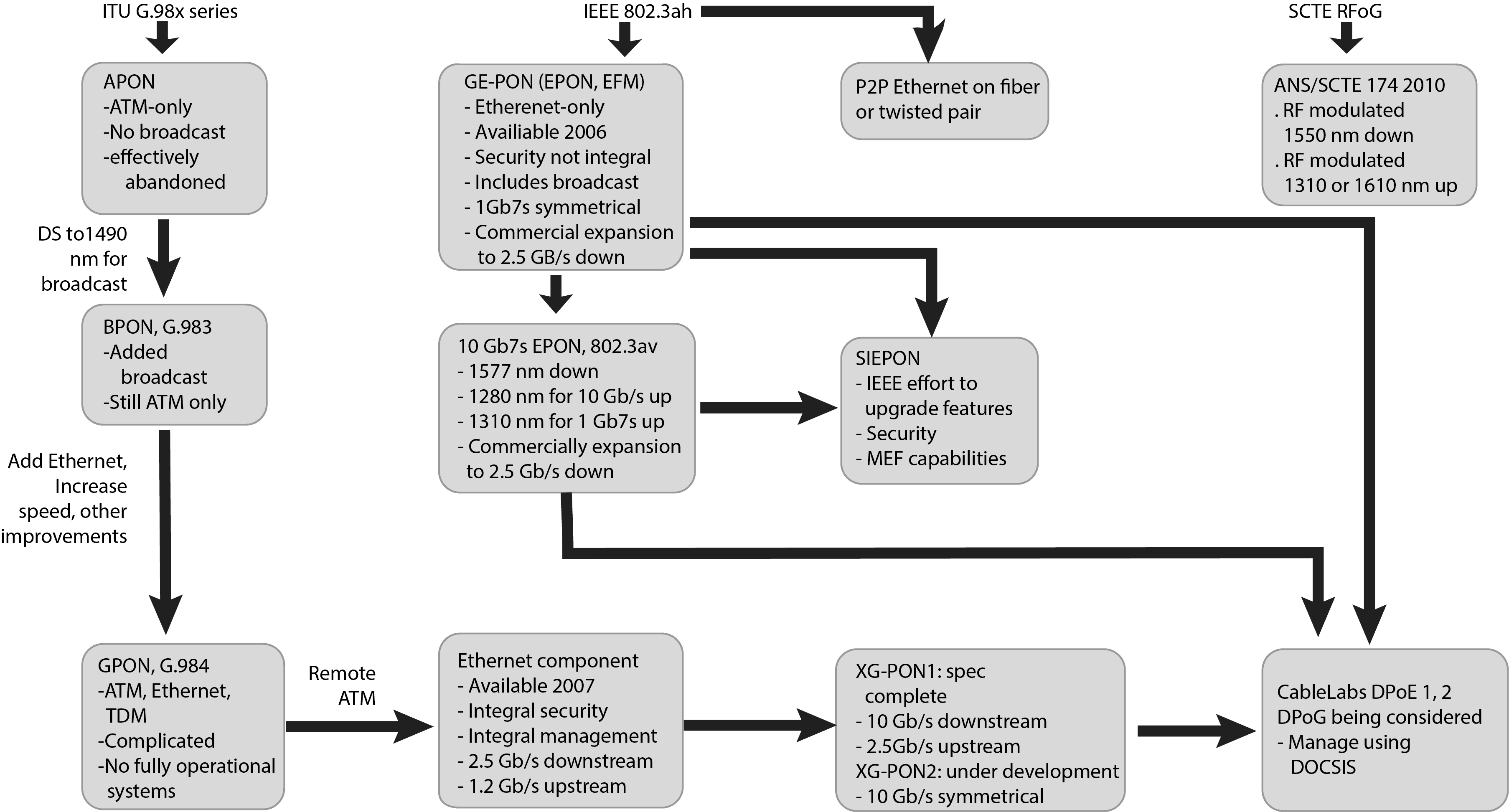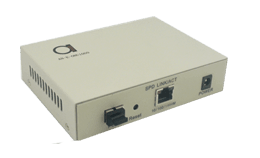This report is our try that aims to explain in brief the current FTTH and FTTx (Fiber to The Premises) networks that are utilized together with a couple of other networks for historical records and what PON protocols and PON standards are used in these networks.
When we talk about FTTH networks, we refer to binary data circulating on the same optical fiber and there are two sets of standards to implement.
The first was the ATM over PON/ITU’s APON (Passive Optical Network) system launched during the 90s.

Figure 1: Overview and development of PON protocols and standards
This has set the broader engineering components of subsidiary networks, and was utilized first in a trial mode, but currently, we haven’t noted any systems like that being employed.
This system was funded on Asynchronous Transfer Mode (ATM), a level 2 protocol basically antagonizing Ethernet) and protocol that has been utilized to this day broadly, in telephone communications among other applications.
There was no arrangement for broadcast video and during that phase, employing the IPTV protocol wasn’t a viable option.
APON was later adjusted to release the 1550nm wavelength for frames by reducing the wavelength range at 1490nm.
This one launched the BPON (Broadband Passive Optical Network) which provided an utmost speed of 155Mb/s and has been utilized broadly in the largest part of Verizon FiOS system, together with other applications.
Engineers noted the necessity of faster speeds and Ethernet was leading the race of layer 2 systems. Thus, the ITU (International Telecommunication Union) finally approved the GPON G984 standard in 2004.
This begun with BPON and raised the max. downstream speed to the range of 2.488 Gb/s and the upstream speed to the range of ½ Gb/s.
Additionally, it introduced Ethernet and TDM carriage to ATM transport found in the standard already. However, the introduction of these extra layer 2 transportation standards, has deemed the application of the standard very complicated and this resulted in a “status quo” commercially-wise for a couple of years.
People knew that these transport standards were no longer necessary.
Ethernet, which was introduced as a corporate standard for business data systems, has became better in multiple aspects, and the costs of preserving it were falling significantly.
Therefore the Ethernet component of GPON was developed into chip systems, efficiently removing other unnecessary components. This has increased the feasibility of the product commercially and from that point, many operators and entities with telephone communication histories have utilized GPON.
At the same time, the Institute of Electrical & Electronic Engineers, which handled the Ethernet Standard, has been introducing its own mode of FITH to the Ethernet Standard.
This addition was officially named “802.3 ah” and you will see in some instances this name appearing. The standard became approved in 2004 (like the GPON standard) and the 802.3 standard was later upgraded while the 802,3ah was added to it.
Just like in the case of regular IEEE Ethernet task, the EPON standard determined just the basic components needed to apply the PON standard.
EPON excluded extensive supervision protocols and encryption systems, which were added to the GPON standard later.
Therefore, the commercial interests remained with the option to implement the current characteristics to compensate for any lacks. This implied that the EPON standard was basically less hard to apply compared to the GPON standard so towards the half of the decade, chip systems were released in the market for EPON and a number of producers, who were formerly manufacturing equivalent PON networks, had changed to EPON.

Figure 2: One of early releases of AD-net’s EPON ONU’s – early 2008.
EPON had managed to gain some big footing in Asia, who was seeking for more upgraded telecommunication systems. It has also won ground in America and Europe, even though its initial followers in these fields were anticipating the arrival of GPON.
EPON is also being referred to with various other names, including among others “Ethernet in The First Mile” and “Gigabit Ethernet PON”.
The initial 802.3ah team perceived the system closest to the follower as the first mile whereas other folks, including authors, consider this as the last mile–it’s just a matter of where you notice the network’s start. Apart from the PON standard, 802.3ah determined P2P Ethernet to the Home, either on fiber or a bend set.
Some time following the 802.3ah approval, numerous other connected activities emerged.
A task team was launched under the 802.3ah term to decide upon the matter of upgrading the speed to 10Gb/s.
This team has eventually completed all its tasks and the 10G-EPON of 10 Gb/s was added to the 802.3 standards. Another team called SIEPON was launched to fill in some of gaps of EPON standard, for the purpose of making it more powerful for corporate uses.
These lacking components were developed partly on the tasks of MEF (Metro Ethernet Forum), which was funded from the previous DSL Forum to advertise Ethernet as a solution beyond corporate usage, by introducing elements that made Ethernet gain some attributes similar to ATMs at a fraction of the original cost.
The cable TV sector in the U.S has also expressed interest for EPON as a tool to antagonize telephone corporations adopting GPON, as the next establishment higher than the tested and real HFC.
A few folks in the industry were worried though, concerning some specific control approaches and methods used on EPON, which were incompatible with the management of DOCSIS cable modem networks, which have acquired the largest piece of the residential data industry.
Big cable owners had built very integrated management networks within the basis of DOCSIS, and they noticed that implementing EPON to use these management networks, would make the task of gradually introducing EPON to their HFC networks much easier.
The switch of HFC systems to FTTH isn’t possible instantly, from a physical and financial perspective. Therefore, the plan was to grow a new plant, probably in greenfields and corporate areas where the cable began to be introduced along with FTTH, whilst at the same time continue to handle the current HFC plant for some years.
Respectively, CableLabs introduced the DOCSIS offering of EPON (DPoE) task, which at the moment of writing this piece, had created two revisions which determine the way/s to conform EPON so it can be controlled by de facto DOCSIS management networks.
Still, more tasks were lined up. Another approach to the method of upgrading HFC to FTTH, was to develop physical systems based on FITH fundamentals, as stated previously in this report, for maintaining the current DOCSIS framework at the edges.
The SCTE (Society of Cable Telecommunications Engineers) initiated this standardization attempt. Instead of terminating the system with OLTs (Optical Line Termination) at the hub, and regular ONTs (Optical Network Terminal) at home, the system would get terminated at the headend with means equivalent to the ones utilized in HFC networks, excluding that HFC utilized much of the 1310 downstream transmission, and in the entire FTTH networks, this wavelength range is kept for upstream transportation.
Downstream transportation would be kept at 1550 nm (a specifically viable wavelength range as the amount of fiber loss is highly limited, and cost-effective optical boosters are more usable.
There were two choices set in regards to the upstream wavelength range: the first was 1310 nm for those seeking the most cost-effective equipment and didn’t seek to add PON data on the same fiber.
The second choice was for upstream transportation at 1610nm, which also allow the fiber system to allow PON transportations. The approval phase was finished in 2010.
Additionally, there is another attempt lined up under the investigation of IEEE, which plans to enable cable users to switch incrementally their existing HFC plants to PON, through the replacement of nodes with a new machine which will alter the PON optical transmissions to electrical forms for transportation to the home or current coax.
This attempt also goes by the name “EPON Protocol Over Coax”. Consecutively, it also intends to utilize the physical level of another CableLabs act, DOCSIS 3.1. which is a determined attempt to offer a much greater bandwidth range, over HFC systems by extending the bandwidth utilized by DOCSIS through the use of more effective management ways.


